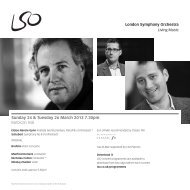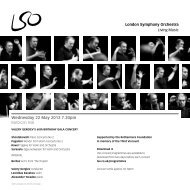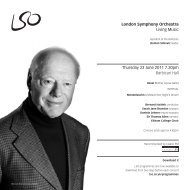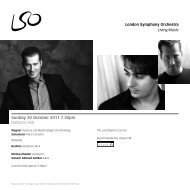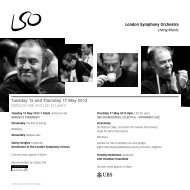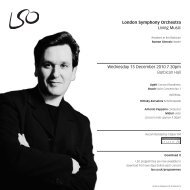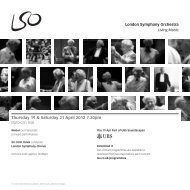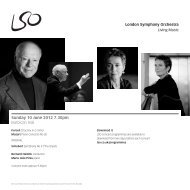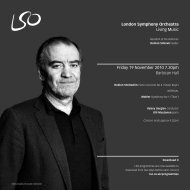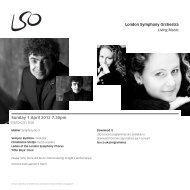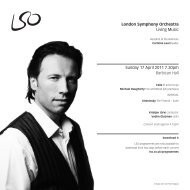25 September programme - London Symphony Orchestra
25 September programme - London Symphony Orchestra
25 September programme - London Symphony Orchestra
Create successful ePaper yourself
Turn your PDF publications into a flip-book with our unique Google optimized e-Paper software.
Modest Mussorgsky (1839–81) orch Maurice Ravel (1875–1937)<br />
Pictures at an Exhibition (1874 orch 1922)<br />
Promenade<br />
1 Gnomus<br />
Promenade<br />
2 Il vecchio castello<br />
Promenade<br />
3 Tuileries (Dispute d’enfants après jeux)<br />
4 Bydło<br />
Promenade<br />
5 Ballet of the Unhatched Chicks<br />
6 Samuel Goldenberg and Schmuÿle<br />
7 Limoges: Le marché (La grande nouvelle) –<br />
8 Catacombae (Sepulchrum romanum) –<br />
Cum mortuis in lingua morta<br />
9 The Hut on Hen’s Legs (Baba Yaga) –<br />
10 The Great Gate of Kiev<br />
Victor Hartmann’s promising career as an architect, painter, illustrator<br />
and designer was cut short by his death at the age of 39 in 1873.<br />
In February 1874 there was a memorial exhibition of his work in<br />
St Petersburg, and this was the stimulus for Mussorgsky to compose<br />
his piano suite Pictures at an Exhibition to the memory of his dead friend.<br />
The Hartmann exhibition contained 400 items. Only a quarter of them<br />
have survived, and of these only six relate directly to Mussorgsky’s<br />
music. Among the lost works are the inspirations behind Gnomus,<br />
Bydło, Tuileries, Il vecchio castello and Limoges. This hardly matters,<br />
though, because Mussorgsky’s imagination goes far beyond the<br />
immediate visual stimulus. It tells us little about the music to learn that<br />
the half-sinister, half-poignant Gnomus was inspired by a design for a<br />
nutcracker (you put the nuts in the gnome’s mouth), or that Baba Yaga<br />
was a harmless and fussy design for a clock, hard to connect with<br />
Mussorgsky’s powerful witch music. Goldenberg and Schmuÿle are<br />
actually two separate drawings, and the dialogue between them is an<br />
invention of the composer’s.<br />
Mussorgsky, a song composer of genius, could sum up a character,<br />
mood or scene in brief, striking musical images, and this is what he<br />
does in Pictures. The human voice is never far away: Bydło, a picture<br />
of a lumbering ox-cart, and Il vecchio castello (The Old Castle) could<br />
well be songs; some of the Promenades and The Great Gate of Kiev<br />
suggest the choral tableaux in his operas; in Goldenberg and Schmuÿle,<br />
the differences between the rich Jew and the poor Jew are suggested<br />
by their different ‘speech patterns’; in Tuileries we hear the cries of<br />
children playing and in Limoges the squabbling of market-women.<br />
Pictures might have been just a loose collection of pieces, but<br />
Mussorgsky in fact devised something far more complex and<br />
interesting. The Promenade that links the pictures is on one level a<br />
framing device, representing the composer (or perhaps the listener)<br />
walking around the exhibition. Sometimes he passes directly from one<br />
picture to another, without reflection. Sometimes he is lost in thought.<br />
On one occasion, he seems to be distracted by seeing something out<br />
of the corner of his eye (the false start to the Ballet of the Unhatched<br />
Chicks), and turns to look more closely. Cum mortuis is not itself a<br />
picture, but represents the composer’s reflections on mortality after<br />
seeing the drawing of Hartmann and two other figures surrounded<br />
by piles of skulls in the Paris catacombs. The composer is also drawn<br />
personally into the final picture as the Promenade emerges grandly<br />
from the texture of The Great Gate of Kiev.<br />
Although Mussorgsky must have played Pictures to his friends, there<br />
is no record of any public performance until well into the 20th century.<br />
It was indeed only after the success of Ravel’s orchestration that<br />
performances of the piano version became at all common. The piano<br />
writing of Pictures is often said to be unidiomatic, and Mussorgsky<br />
certainly never cared for conventional beauty of sound or pianistic<br />
virtuosity for its own sake. There are certainly aspects of the texture<br />
that are hard to bring off successfully, such as the heavy chordal style<br />
of some Promenades, Bydło and The Great Gate of Kiev; the tricky<br />
repeated notes in Goldenberg and Schmuÿle and Limoges; and the<br />
sustained tremolos in Cum mortuis and Baba Yaga. But these are all<br />
part of Mussorgsky’s desired effect.<br />
Pictures at an Exhibition has been subjected to many arrangements<br />
(including one by Proms founder-conductor Henry Wood), but none<br />
so brilliant as Ravel’s, which was commissioned by the Russian<br />
conductor Serge Koussevitzky, and first performed by him in Paris<br />
on 19 October 1922. Ravel was<br />
already a great enthusiast for<br />
the music of Mussorgsky. He had<br />
collaborated with Stravinsky on<br />
orchestrating parts of his opera<br />
Khovanshchina for Diaghilev’s<br />
Paris performances in 1913, and<br />
far preferred Mussorgsky’s barer<br />
original score of Boris Godunov<br />
to the more colourful edition by<br />
Rimsky-Korsakov. With Pictures<br />
there are only three major<br />
The Great Gate of Kiev differences between Ravel’s<br />
Victor Hartmann<br />
orchestration and the piano<br />
original, which he knew only<br />
from Rimsky’s 1886 edition: the omission of a Promenade between<br />
Goldenberg and Schmuÿle and Limoges; the addition of some extra<br />
bars in the finale; and the dynamics of Bydło, which Mussorgsky<br />
marked to begin loudly, not with a slow crescendo.<br />
Ravel’s orchestral colours and techniques are far more elaborate<br />
than anything that Mussorgsky might ever have conceived, so his<br />
work must be considered more a free interpretation than a simple<br />
transcription. Some of his choices of instrumentation for solo<br />
passages are unforgettable: the opening trumpet, for example, or<br />
the alto saxophone in Il vecchio castello and the tuba in Bydło.<br />
Even more remarkable is the range of colour that Ravel achieves, and<br />
the way in which the essence of the music is faithfully reproduced<br />
while the original piano textures are presented in an altogether<br />
different sound medium. Ravel and Mussorgsky could hardly have<br />
been more different as men and as composers, but Pictures at an<br />
Exhibition has justly become famous as a collaboration between two<br />
great creative minds.<br />
Programme note © Andrew Huth<br />
Andrew Huth is a musician, writer and translator who writes<br />
extensively on French, Russian and Eastern European music.<br />
Modest Mussorgsky (1839–81)<br />
Composer Profile<br />
Modest Mussorgsky was born in Karevo, the youngest son of a<br />
wealthy landowner. His mother gave him his first piano lessons, and<br />
his musical talent was encouraged at the Cadet School of the Guards<br />
in St Petersburg, where he began to compose (despite having no<br />
technical training) – in 1856, the year that he entered the Guards, he<br />
attempted an opera. In 1857 he met Balakirev, whom he persuaded<br />
to teach him, and shortly afterwards began composing in earnest.<br />
The following year Mussorgsky suffered an emotional crisis and<br />
resigned his army commission, but returned soon afterwards to<br />
his studies. He was, however, plagued by nervous tension, and this,<br />
combined with a crisis at the family home after the emancipation of<br />
the serfs in 1861, stalled his development quite severely. By 1863,<br />
though, he was finding his true voice, and he began to write an opera<br />
(never completed) based on Flaubert’s Salammbô. At this time he<br />
was working as a civil servant and living in a commune with five<br />
other young men passionate about art and philosophy, where he<br />
established his artistic ideals.<br />
In 1865 his mother died; this probably caused his first bout of<br />
alcoholism. His first major work, Night on Bare Mountain, was<br />
composed in 1867, and soon afterwards, fired by the ideas discussed<br />
in Balakirev’s circle (‘The Mighty Handful’) he began writing his opera<br />
Boris Godunov; a little later he also began work on another opera,<br />
Khovanshchina. Heavy drinking was once again affecting his creativity,<br />
though he did write the piano work Pictures at an Exhibition in a<br />
short time. By 1880 he was obliged to leave government employment,<br />
and despite the support of his friends, he lapsed still further,<br />
eventually being hospitalised in February 1881 after a bout of<br />
alcoholic epilepsy. It was during a brief respite that Repin painted his<br />
famous portrait of the composer, but within two weeks of that work,<br />
Mussorgsky died.<br />
Profile © Alison Bullock<br />
Alison Bullock is a freelance writer and music consultant whose<br />
interests range from Machaut to Messiaen and beyond. She is a<br />
former editor for the New Grove Dictionary of Music and the LSO.<br />
8 Programme Notes Programme Notes 9



